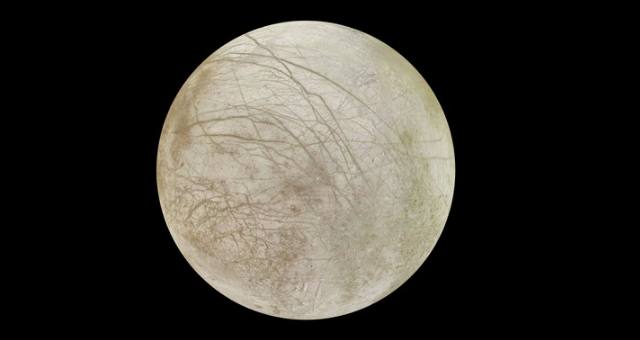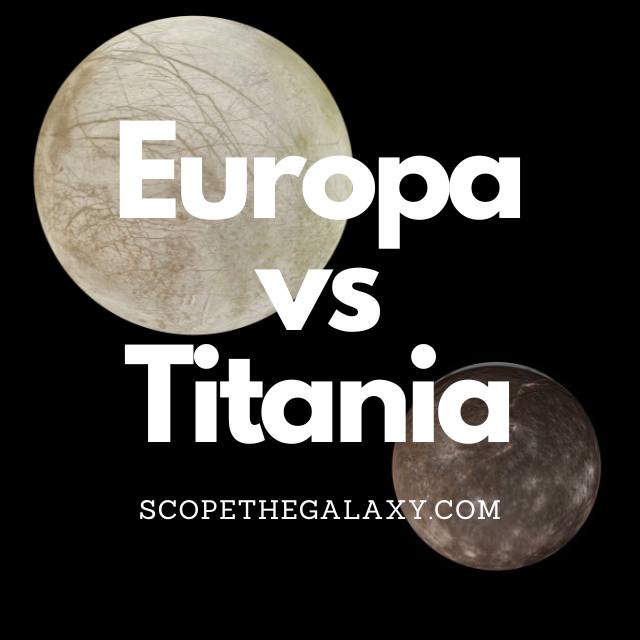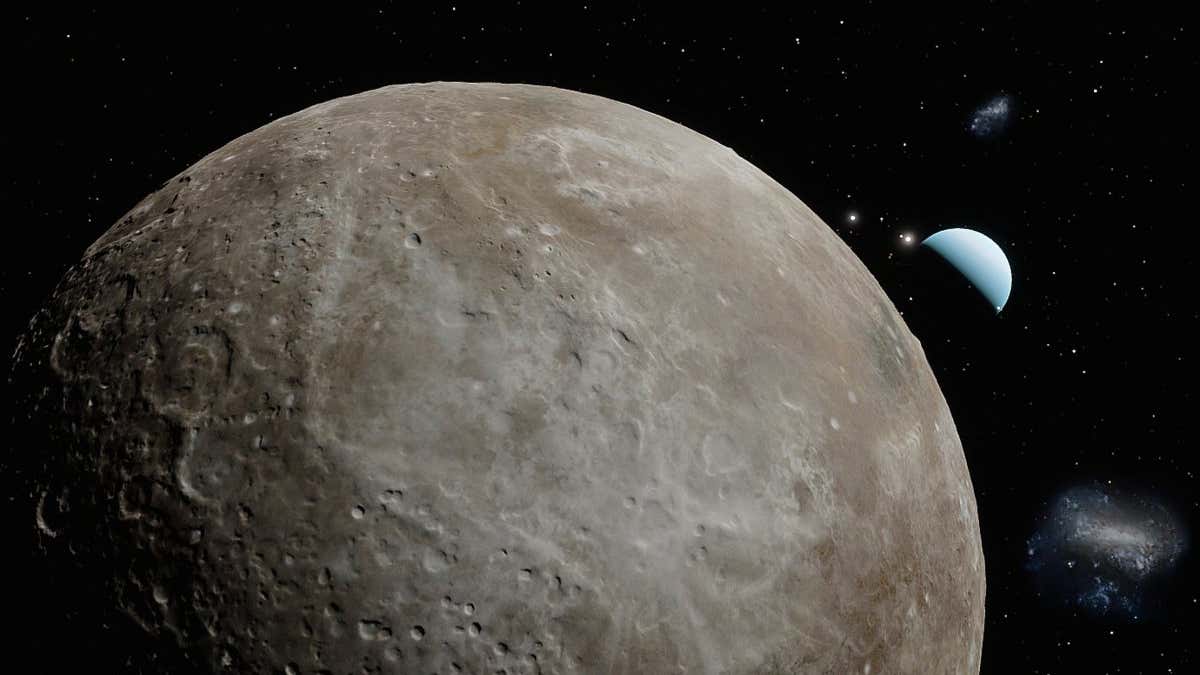*This post may contain affiliate links. This means we may make a commission if you purchase an item using one of our links*
The main differences between Europa and Titania would be that Europa is bigger with a diameter of 3,121.6km while Titania’s diameter is 1576.8km, Titania orbits Uranus while Europa orbits Jupiter and a day on Titania is longer at 8 days 17 hours compared to Europa’s 3.5 days.
There are various other differences between the two so continue reading for a more detailed breakdown of both entities along with their similarities and differences below.
What Is The Moon Europa?
Table of Contents

Europa is the smallest of the Galilean moons, first discovered on 8th January 1610. The surface of this icy world is frozen, but scientists believe a watery ocean could lie beneath the surface. And in 2012, researchers found a possible water plume in the Southern polar region of Europa.
This research is yet to be confirmed; still, it gives us reasonable grounds to hypothesize that water could exist on this icy moon.
Estimates place Europa at around 4.5 billion years old (the same age as its planet, Jupiter), and its average distance from the Sun is approximately 780 million km.
It has a diameter of 3,121.6km, which makes it larger than Pluto but smaller than the Earth’s moon, and the maximum temperature is a chilly -160 degrees Celsius. In regards to mass, it measures in around 4.8 × 10^22 kg.
Europa takes three-and-a-half days to orbit its planet at an average distance of 670,900km, and it is tidally locked, meaning the same side of the moon always faces Jupiter.
Among the fascinating features of this ice moon is its incredibly reflective nature. The icy crust of this body provides a light reflectivity of 0.64 – the highest of any moon in the solar system.
Data from the Galileo spacecraft suggests that Europa is composed of an iron core, rocky mantle, and silicate rock (a similar composition to Earth).
The moon’s surface is covered in cracks, which many theorize could result from tidal currents beneath the surface. It is this potential of water – and of life – that keeps astronomers so interested in this moon.
Europa might be small, but astronomers estimate it holds two to three times more water than the Earth. In addition, this moon possesses the essential elements for life, such as carbon, oxygen, hydrogen, and nitrogen.
There may be no solar energy on this moon, but hydrothermal vents could provide energy, and tidal heating from Jupiter could provide a heat source and keep the moon stable enough for life to form. In addition, the liquid ocean is well protected from radiation from thick, icy surfaces.
What Is The Moon Titania?
Titania is the biggest of Uranus’s moons, with a circumference of 4,956km and a diameter of 1576.8km.
The high density of this moon suggests that it most likely formed from a collection of dust and debris leftover from the formation of Uranus or from the debris created in the collision that reportedly tilted Uranus onto its side. As a result Titania has a mass of 3.4 × 10^21 kg.
First discovered on 11th January 1787 (the same day as the discovery of Oberon, the second biggest moon of Uranus) by British astronomer William Herschel, the name “Titania” comes from the Shakespeare play, A Midsummer Night’s Dream. (Most of Uranus’ moons are named after Shakespeare’s characters.)
Having observed Titania for many years, scientists theorize that its composition is likely to be equal parts ice and rock, the latter of which may contain carbonaceous materials and organic compounds.
Research suggests that the moon most likely has a rocky core (accounting for 66% of the moon’s radius) and an icy mantle. If the mantle contains ammonia, it will act as antifreeze and make it possible for liquid water to exist. In this instance, the moon could possess a layer of liquid ocean around 50km thick.
Titania tilts slightly towards the equator of Uranus and is tidally locked to its planet. This means a Titania day is 8 days and 17 hours which would be the same for its orbital cycle. Titania has an average temperature of -203 degrees Celsius.
The planet Uranus is also tilted, with the moons orbiting on the equatorial plane, giving it extreme seasons. On Titania, the north and south poles experience 42 years of complete sunshine followed by 42 years of total darkness.
Scientists have observed the presence of large amounts of carbon dioxide, suggesting this may be the primary component of this moon’s atmosphere. Thanks to the tilted orbit, and a concentration of solar radiation from the poles, Titania probably maintains a carbon dioxide cycle, similar to the hydrogen cycle on Earth.
How Are Europa And Titania Similar?
As both are natural satellites, Europa and Titania do share a few similarities, which includes the following:
- Both have a hotter central core.
- Both have a rocky, terrestrial surface.
- Both are spherical in shape.
- Neither have rings surrounding them.
- Both are tidally locked to their planet.
- Both orbit their planet in an elliptical pattern.
- Neither have a magnetic field.
- Neither have tectonic plates
Differences Between Europa And Titania
As for the differences between the two, they include the following:
- Europa is the 6th largest moon whilst Titania is 7th as Europa has a diameter of 3,121.6km whereas Titania has a diameter of 1,576.8km.
- Titania orbits Uranus while Europa orbits Jupiter.
- The average temperature on Titania is -203 degrees Celsius whilst Europa has a temperature of -160 degrees Celsius.
- Titania’s thin atmosphere is composed mostly of carbon dioxide whilst Europa’s atmosphere is also very thin but composed mostly of oxygen.
- Europa is made up of water ice and rock while Titania may have ice water under its surface.
- Titania is 435,840 km away from Uranus on average whilst Europa’s average distance is 442,200km from Jupiter.
- Europa is amongst the most luminous moon in our solar system with an albedo of 0.64.
- Titania’s gravitational strength is 0.367 m/s² whilst Europa’s gravity is 1.315 m/s².
- Europa has a density of 3.01 g/cm³ whilst Titania’s density is 1.71 g/cm³.
- A day on Europa is 3.5 days whilst a day on Titania takes 8 days 17 hours.
- As both satellites are tidally locked to their planet, it takes them both the same as a day to orbit their planet meaning Titania takes 8 days 17 hours and Europa completes an orbit in 3.5 days.
- In regards to mass, Titania’s is 3.4 × 10^21 kg whilst Europa’s is 4.8 × 10^22 kg
Summary
Europa and Titania have a few common features between them, such as the fact both are moons that orbit large gas Giants, are amongst the largest moons in the entire solar system, have a similar terrestrial composition and more.
However, they have various differenences too whether it be in regards to their overall size, their atmospheric composition, the activity on their surfaces and more so, Titania and Europa are very different in their own right despite the similar features they share.


